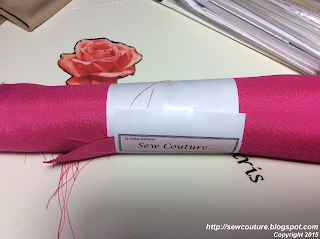Am I the only sewing enthusiast who has a difficult time tossing out fabric remnants from completed projects? I shared with you that I learned how to sew by watching my mother, and how she would use leftover fabric scraps from her clients' garments for other projects, including helping me augment the wardrobe of my Barbie dolls. So, I recognize holding on to fabric scraps as a learned behavior from Mommy.
I have found storing my scraps to be a challenge, partly due to the amount of space they required, but also because I wasn't always sure of the amount of usable "yardage" I had on hand.
Remnants were once stored at the bottom of my Sewing Room closet in a small plastic bin, which proved to be woefully inadequate capacity.
Fabric scraps would then find a temporary "home" in the storage drawers I used to categorize and store uncut fabric yardages.
Not long ago, while browsing through Pinterest for fabric storage ideas, I saw this image and it got me thinking about how better to store my remnants.
In fact, this image, and the blog post from which it originated, reminded of my time working at So-Fro Fabrics and how we packaged remnants once the bolts got down to the final 1 to 1.5 yards of fabric. So, with this image as my inspiration, I used Word to create "wrappers" to document the fabric details and wrap around my remnants for storage. I formatted the document to print two wrappers per page.
After printing a supply of wrappers, I measured each fabric scrap's length and width, identified the fiber content (if possible) and documented the project from which the scrap originated - as a point of reference - and wrapped each using the method I learned at So-Fro.
I allocated the bottom two drawers in my Sewing Room dresser to remnant storage. To maximize capacity, I folded each remnant so it would occupy half of each drawer's depth so I could get two rows per drawer. I also tried to group them in categories (Cotton Wovens, Special Occasion, Linens and Linen-types, etc.) so it would be easier to a find length of fabric whenever the need arises.
I keep extra wrappers on a clipboard in the drawer so I could quickly label and package future scraps, thus avoiding backlog and clutter.
So, here are all - and I do mean ALL - of my fabric remnants in their new "home". This works much better because I'm able to see each item, I know how much is available, and they're not overflowing to other areas of my Sewing Room.
And, when I have no need to find a remnant for another project...
...I can simply close the drawers, and harmonious order is restored. So, do you keep your scraps? How do you store them? Please leave your comments below...I really enjoy reading your thoughts.
Be blessed!
Aisha













This is a great idea! I think I'll incorporate it.
ReplyDeleteI'm really good about tossing scraps. Even if they are large. BUT sometimes it's a fabric I love and I know can be used for contrast, pockets, bias tape, etc and they are just stored in a giant bin.
Totally get it, SewCraftyChemist. Also, sometimes, the scraps are large enough for other projects, especially if it can be combined with other scrap pieces. In fact, I have a post in the queue on that same topic. Thanks for commenting...I so appreciate you!
DeleteThe wrappers are a good idea. I have a RIDICULOUS amount of remnants so most of my stash is already wrapped LOL. That'd be a good idea for the actual SCRAPS I have though.
ReplyDeleteI keep my remnants separated by linings, sheer/lace/contrast fabrics, and regular fashion fabric. They are in bags but it would be nice to find space to put a bin somewhere.
Thanks, Tasha, for the encouragement. And I so glad to know that I am in such good company when it comes to saving/sorting my remnants. Let me know if you move away from the bags as storage. I love seeing how others organize their space. Thanks for commenting!
DeleteAisha, I hear you on the scraps, I have a bin in my sewing room where I keep the ones I really like, if not I give to my daughter for her own projects.
ReplyDeleteAmina's, how fortunate you have someone who can take your "donations". That certainly helps with managing the volume, right? Thank you for sharing...I truly appreciate it.
Delete